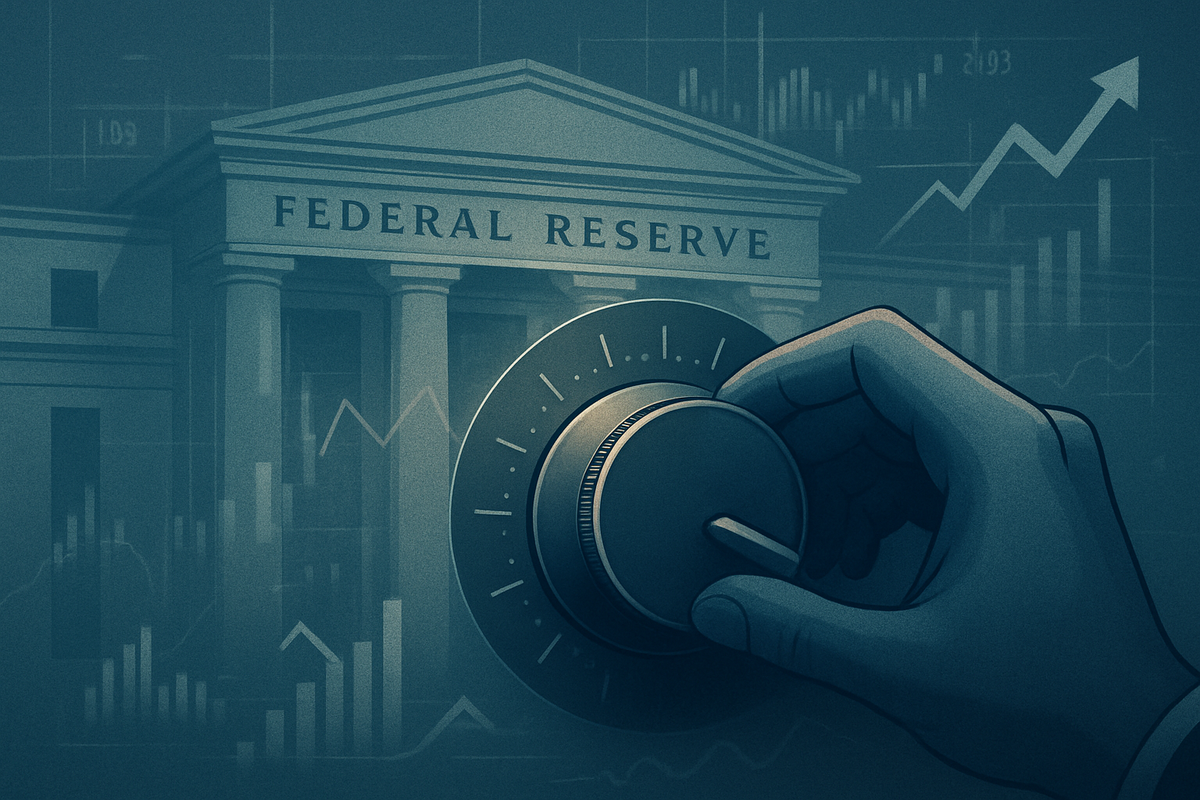
The Federal Reserve stands at a critical juncture, facing an upcoming interest rate decision that is heavily reliant on a clear understanding of the nation's economic health. While the market frequently debates the availability and reliability of economic indicators, Paul Lane of the Armstrong Advisory Group has offered a nuanced perspective, focusing not necessarily on a lack of data, but on the interpretation of existing, albeit weakening, economic signals influencing the Fed's anticipated moves. His comments, made in September 2025, highlighted how specific labor market data were shaping expectations for a potential rate cut, even as broader market discussions in November 2025 sometimes point to a general scarcity of guiding economic information, potentially exacerbated by factors like government shutdowns. This divergence in emphasis underscores the complex environment in which the Fed must operate, balancing various data points and market sentiments to steer monetary policy.
The Fed's Data-Driven Dilemma: Lane's Analysis vs. Broader Market Concerns
Paul Lane's analysis in September 2025 painted a clear picture of an anticipated quarter-percent interest rate cut by the Federal Reserve. According to Lane, the probabilities of such a move were as high as 96%, driven primarily by observable weaknesses in the labor market. He specifically cited two critical pieces of economic data: an uptick in the unemployment rate to 4.3% and a significant revision that saw 911,000 jobs removed from the period between March 2024 and March 2025. These indicators, in Lane's view, provided a strong rationale for the Fed to ease monetary policy despite lingering inflationary concerns. For consumers, Lane projected a corresponding decrease in money market and CD rates, as well as lower rates for home equity lines of credit and credit card debt. Businesses, too, could expect cheaper borrowing costs, potentially stimulating growth, though Lane cautioned that a quarter-point cut would be a modest start.
However, the broader financial landscape in November 2025 has also seen discussions about the Federal Reserve potentially holding interest rates steady due to a more general "lack of economic data to guide monetary policy." This sentiment is often linked to scenarios like a government shutdown, which can disrupt the flow of crucial information on unemployment, inflation, and retail spending. It is important to note that while the market is grappling with the implications of potentially incomplete data, Paul Lane's specific commentary, as researched, centered on the interpretation of available, albeit concerning, economic data to inform the Fed's rate decision, rather than a direct lament over a complete absence of data. This distinction highlights the different facets of the data challenge facing the Fed: not just whether data exists, but how it is interpreted and prioritized.
Corporate Winners and Losers in a Shifting Rate Landscape
The Federal Reserve's interest rate decisions, whether based on existing data or in the face of data scarcity, inevitably create winners and losers across various sectors. If the Fed proceeds with a rate cut, as anticipated by Paul Lane in September 2025 due to weakening labor data, several industries could see a boost. Financials (NYSE: JPM, NASDAQ: BAC) could initially face margin pressure from lower lending rates, but increased borrowing activity from consumers and businesses could offset this. Real Estate companies (NYSE: SPG, NASDAQ: PLD) and homebuilders would likely benefit significantly from lower mortgage rates, stimulating demand and making property more affordable. Consumer Discretionary firms (NASDAQ: AMZN, NYSE: HD) could also see increased spending power as consumers pay less on debt and have more disposable income. Growth-oriented Technology companies (NASDAQ: MSFT, NASDAQ: AAPL), which often rely on cheaper capital for expansion and whose valuations are sensitive to discount rates, typically perform better in a lower interest rate environment.
Conversely, if the Federal Reserve were to hold interest rates steady due to broader concerns about a lack of clear economic data or persistent inflation, the impact would shift. Banks might see their net interest margins stabilize or improve if deposit rates fall slower than loan rates, but overall lending volume might stagnate. Companies with high debt loads could face continued pressure from elevated borrowing costs. Sectors sensitive to consumer spending might see demand soften if borrowing remains expensive. Furthermore, if the uncertainty surrounding economic data persists, it could lead to increased market volatility, impacting companies across the board by making long-term planning and investment decisions more challenging. Investors might flock to more stable, dividend-paying stocks or sectors perceived as less sensitive to economic cycles, such as Utilities (NYSE: DUK, NASDAQ: NEE) or Consumer Staples (NYSE: PG, NASDAQ: KO).
Broader Implications and Historical Parallels
The Federal Reserve's current predicament—navigating an interest rate decision amidst conflicting data interpretations or perceived data scarcity—fits into broader industry trends concerning monetary policy and economic forecasting. The Fed's dual mandate of maximizing employment and maintaining price stability requires precise economic insights. When these insights are either ambiguous, as in Paul Lane's discussion of weakening but present labor data, or potentially incomplete, as in the broader market's concern over data lack, the institution's ability to act decisively is challenged. This scenario can lead to increased market uncertainty, as investors and businesses struggle to predict future policy directions.
Potential ripple effects could extend to global markets, as the Fed's actions influence currency valuations, capital flows, and international trade. Regulatory bodies might face calls for enhanced data collection and transparency, particularly if issues like government shutdowns impede critical economic reporting. Historically, periods of economic data uncertainty have often led to more cautious or delayed policy responses from central banks. For instance, during the early 2000s, after the dot-com bust, the Fed navigated a period where traditional economic indicators provided mixed signals, necessitating a careful, incremental approach to rate adjustments. More recently, during the COVID-19 pandemic, policymakers had to make unprecedented decisions with rapidly evolving and often incomplete real-time data, highlighting the critical need for robust and timely economic information. The current situation, while different in its specifics, echoes these past challenges, emphasizing the foundational role of reliable data in effective monetary policy.
The Road Ahead: Potential Scenarios and Market Adaptations
Looking ahead, the Federal Reserve's path is fraught with both short-term and long-term possibilities, heavily contingent on the evolution of economic data and global events. In the short term, if the labor market continues to show signs of weakening, as Paul Lane's September 2025 analysis suggested, a quarter-point rate cut remains a plausible scenario. This could offer immediate relief to borrowers and potentially stimulate economic activity. However, if broader concerns about a lack of comprehensive economic data persist, or if inflationary pressures unexpectedly resurface, the Fed might opt for a "wait and see" approach, holding rates steady to avoid premature action. This could lead to continued market volatility as investors seek clarity.
In the long term, the Fed might need to consider strategic pivots in its communication and data collection methodologies. Enhanced collaboration with private data providers or the development of more resilient government data infrastructure could become priorities. For investors, this environment demands adaptability. Opportunities might emerge in sectors resilient to economic uncertainty or those poised to benefit from specific policy shifts, such as infrastructure or renewable energy if government spending increases. Challenges include navigating increased market noise and the potential for sudden policy reversals based on new data. Potential scenarios range from a "soft landing" where inflation is tamed without a significant recession, to a more challenging "stagflation" environment if growth stagnates while prices remain high. The market will closely watch for any fresh economic releases, the Fed's public statements, and global economic developments to gauge the most likely outcome.
Conclusion: Data's Enduring Influence on Monetary Policy
The Federal Reserve's upcoming interest rate decision encapsulates the enduring and often complex influence of economic data on monetary policy. Paul Lane of Armstrong Advisory Group highlighted how specific, albeit weakening, labor market data in September 2025 strongly pointed towards an anticipated rate cut, providing a clear rationale for easing. Yet, the broader market discourse in November 2025 also reflects concerns about a general "lack of economic data" to effectively guide the Fed, potentially stemming from disruptions like government shutdowns. This dual perspective underscores the critical challenge facing policymakers: not only interpreting the data that is available but also contending with the implications of what might be missing.
Moving forward, investors should closely monitor several key indicators. The continued health of the labor market, inflation trends, and any new statements from Federal Reserve officials will be paramount. The market will also be keen to see if any perceived data gaps are filled, or if the Fed adapts its communication strategy to address the uncertainty. The ability of companies to navigate fluctuating interest rates and economic uncertainty will differentiate market performers. Ultimately, the Fed's decisions will continue to shape the financial landscape, making the availability and interpretation of robust economic data an ongoing focal point for both policymakers and market participants in the months to come.
This content is intended for informational purposes only and is not financial advice






